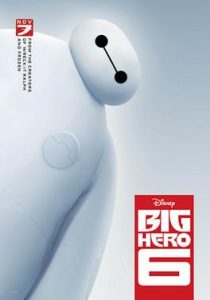
(Sight & Sound, BFI – I also wrote an article on the film’s production for the MangaUK blog.)
I saw Disney’s CGI cartoon Big Hero 6 when it premiered at the Tokyo International Film Festival, promoted under its Japanese title Baymax. This is also the name of the marshmallow-textured, blow-up droid who supports a bereaved boy through grief and anger. Baymax steals the film, a loveable, inherently cartoonish creation, given to motherly hugs, whoopee-cushion deflations, squashes and stretches, and an endearing, fastidious awkwardness worthy of Christopher Reeve’s Clark Kent.
Baymax is placed in a superhero story – specifically a Marvel superhero story, based on a Marvel comic which began in 1998. (The film is tied up post-credits by a mildly amusing animated cameo from Stan Lee.) Unlike Pixar’s The Incredibles (2004), which highlighted middle-aged angst, Big Hero 6 sets up a plucky band of kid science prodigies who forge themselves into a junior Avengers, making future technology their superpowers in a fantasy metropolis. The city is a mishmash of San Francisco and Tokyo (‘San Fransokyo’) where the Golden Gate Bridge has Shinto-style gates, there are trams on steep streets, and giant Asian ‘lucky cat’ figures.
The hero-group story sometimes clashes with the plotline which Big Hero 6 wants us to care about – the relationship between Baymax and one of the kids, the boy Hiro who loses his big brother (Baymax’s inventor). This is a touching story; it never approaches the poetic pathos of Pixar’s Up (2009), but younger viewers who’ve suffered their own loss may connect with the emotionally skittish Hiro more than with Up’s curmudgeonly Carl Friedricksen. The film takes a startling turn for a Disney cartoon when Hiro’s grief turns into murderous anger, though the way it’s resolved feels too pat and easy.
Beyond the emotional tentpoles of Baymax and Hiro, the script is smart and enjoyable, but the plot eventually descends into comic-strip staples. The climax, for example, takes place in a colourful chasm of urban debris and taffy shapes, which is very impressive to watch, but it still feels like a premature remake of the finale of Avengers Assembled (2011). The other kid heroes feel, if not quite one-note, then surplus to the film. They’d work better in a TV series where their personalities could fill out over successive weeks. Big Hero 6 strikes an arch tone about comic-strip clichés – these kids know they’re in a comic-strip adventure – yet it still resorts to the Enid Blyton Famous Five device of characterising its two main females as a pink (if feisty) girly girl and a tomboy.
Action scenes in CGI are usually much more distancing than in live-action, yet Big Hero 6 pulls off an excellent mid-film car chase, artfully kinetic and exciting. Later, Baymax takes to the sky in a crimson power suit like a barrel-shaped Iron Man; it’s an exhilarating image, but feels more generic, which the later battles are standard-order action fare. Baymax himself lifts a good adventure cartoon film into something rather better. However, it’s doubtful if he’s a strong enough promotional image to raise the film near the box-office stratosphere of Disney’s Frozen.
[amazon_link asins=’B00SYEOXRA,B00XLUBWN0′ template=’ProductCarousel’ store=’anime04c-21′ marketplace=’UK’ link_id=’e420a3d8-ace6-11e8-a1ff-277c7acc9c44′]